Here’s another follow-up to my planting of bare root raspberry canes. You can view my previous posts on preparing the soil, selecting the varieties, protecting from rabbits, one week update, and one month update.
I originally planted my bare root raspberry canes on June 2. On the advice of a gardener friend, I decided to put a very thin layer of mulch down around the plants. I thought the most likely reason for losing one of the canes was the roots drying out. I’m not sure why that one didn’t make it when the others around it have done fine. Interestingly, Nourse Farms (where I ordered my plants), suggests NOT putting down mulch. My friend suggested it for two reasons. First, he said it would help keep in moisture. Second, it might suppress growth of some of the competing plants that I’m dealing with – grass, clovers (oxalis), and other weeds. The grass is mostly my fault for not preparing the soil far enough in advance. The clovers are a nuisance throughout my back yard but have actually been pretty well controlled last year and this year in the grass. As for weeds, I do have some growth of stuff that I have no idea what it is. I keep hoping that they are more primocanes, but unfortunately, I think it is just some competing weeds.
The only downside of laying mulch which I could find was that it may extend the producing season of the plants. This sounds like a good thing, except apparently the plants also need to prepare for the cold. If it gets very cold quickly and the plants aren’t adequately preparing, they may have more trouble surviving a cold winter. I have also read quite a bit about root rot. I initially was worried about overwatering my plants for this reason. At this point, I think the bigger risk to my plants is inadequate water and the roots drying out, as opposed to root rot. Of course, that is a risk, but I’m hoping that won’t be a problem. My soil is clay and not the quickest draining, but I also don’t seem to get any standing water in my yard either, so I’m thinking I’ll be okay.
Here’s some pictures from July 3, right after I put down the mulch.
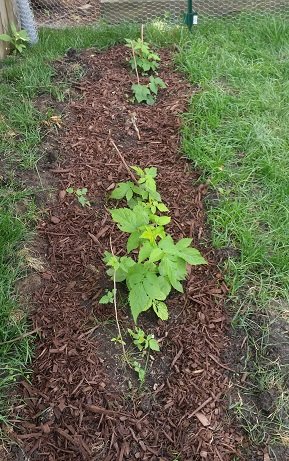
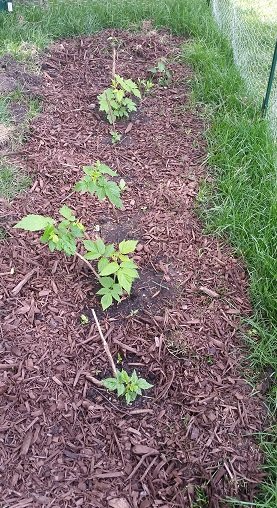
The biggest surprise during this second month has been flowering! Starting on July 13, I noticed some flowers forming on the growth coming from the floricanes. Both varieties I planted are considered “everbearing” meaning that they produce raspberries on the primocanes – the plants that grow the first year – in the fall. Additionally, they grow raspberries on the floricanes the following summer – basically the second year of the shoots life. The bare root canes (as far as I understand it) are floricanes with roots. The roots will send up primocanes and I expected the floricanes to essentially be inactive. On several of the floricanes, though, I have gotten some growth and leafs. I didn’t think anything of it. Then I saw some flowers forming on one of the Joan J floricanes in the sunnier section and I noticed what looked like flower buds on one of the Anne floricanes. Here’s a picture of one of the flowers on the Joan J from July 13:
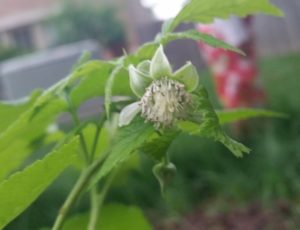
I’m excited about the flowers because these flowers are what turn into raspberries! I wasn’t expecting to get any raspberries this early. I was hoping maybe I’d get some raspberries from the primocanes that are growing this fall, but I was thinking I most likely wouldn’t see any raspberries until next fall – assuming everything grows as it should.
On July 20 I noticed the second Joan J that had earlier been pruned by my cute, yet frustrating, rabbits, was turning yellowish on the growth that seemed to be struggling along since the rabbit incident. Ultimately it looks like this plant isn’t going to make it either. It appears I had three Joan J canes in the sunnier row and two of them were killed by rabbits. The remaining one in that row is doing well. And all of the Joan J in the shady row look to be doing well.
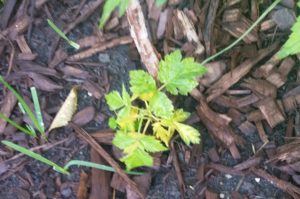
June 23, the plant has continued to dwindle and shows no further growth. At this point I’m really glad I did put up the chicken wire when I did, as I otherwise would have likely lost even more plants to the rabbits.
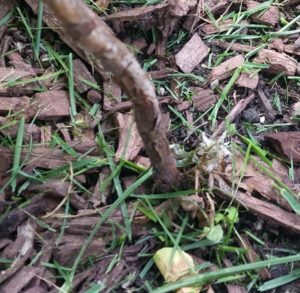
Here’s a picture of some of the raspberries from July 27 – about eight weeks after planting:
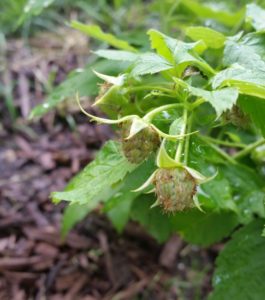
The second big surprise during the second month of growth was that on August 3, I noticed some flowers on one of the Joan J plants in the shadier row. The reason this was a surprise is that the plant is one of the primocanes. I checked closely to make sure it was a primocane and it definitely looks like it. Looking online, it does look like Joan J can start producing raspberries on primocanes in August. Overall, this looks like good news for me getting more raspberries throughout the fall now:
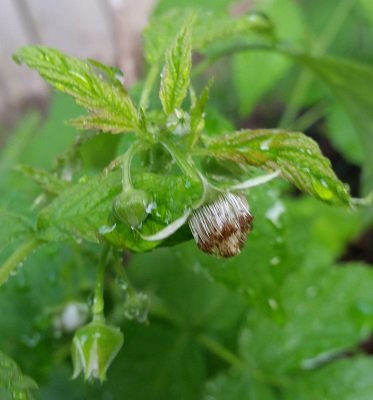
In summary, two months after planting bare root raspberry canes, I have many flowers turning into raspberries on some of the floricane growth. It looks like I’ll have more than a dozen raspberries from the Joan J plants and maybe half a dozen from just one Anne plant. I’m also starting to get some primocane flowers on one of my Joan J primocanes. In the shady row, I planted 5 Joan J plants and one Anne plant. That Anne plant had some floricane flowering early, which wilted and I’ve had no growth from that plant since. The remaining five Joan J plants there all have a some growth with a nice primocane on four of them, one already having growth. In the sunnier row, I’ve got one nice Joan J floricane producing a bunch of raspberries. An Anne floricane is growing a few raspberries, but interesting there is no primocane growing from that plant. I’ve got two other Anne plants growing primocanes. One is pretty good sized and the other is a bit small. I am hoping the Anne plants will grow more primocanes next year, because there won’t be too many floricanes. Here’s some pictures of how the patches look after two months:
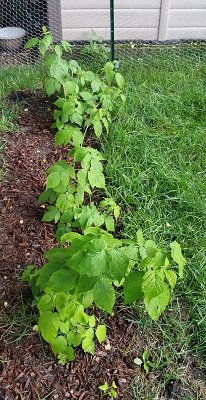
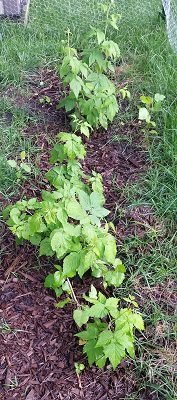
I finally got around to doing an update for the rest of 2016.